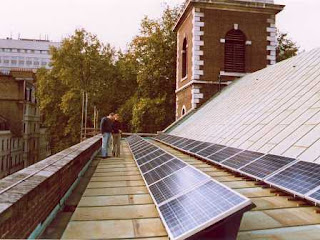 |
| Scholes Farm in Calderdale. That roof's looking a bit bare! |
At first glance you might think Calderdale didn't need much 'Greening'. It is indeed a green and pleasant area and a Council I worked for for a while as their Home Energy Conservation Officer. They pioneered universally free insulation for the over 60s regardless of income before any other Council in the country and did so for around 8 years before funding constraints took hold. Calderdale has Hebden Bridge with the Alternative Technology Centre and more 'right on' folk than you can shake a stick (that may be later used as biomass) at. It also has Todmorden which pioneered the food growing revolution that is 'Incredible Edible'. The Council is also doing some pioneering work on new social housing with high Code for Sustainable Homes standards. So there's a lot for them to shout about on the green front but even the more proactive areas have a blind spot and Calderdale's is their Planning Department's approach to solar PV on listed buildings.
A recent planning application for a solar PV panels on a listed farmhouse at Scholes Farm is a case in point. The applicants wanted to put their panels on a section of roof that was on a new extension to the listed building that could not be seen from the road or particularly easily from anywhere else. Calderdale Planning however reckoned that this was still adversely impacting on the buildings listed status and recommended refusal. All I could imagine that the applicants could have done to make the panels more acceptable to planners would have been to bury them in the garden but this would have rather negated their purpose in life.
 |
| St James Piccadilly Solar Panels |
I advised the applicants of their right to ask one of their local councillors to refer the matter to the Planning Committee for a decision rather than be decided by officers. Fortunately the Councillors could see that the interpretation of government planning policy in this instance was not being regarded as an enabling one but in a more restrictive light. Evidence was ably provided by Mr Adam Gillespie of the Energy Saving Trust on behalf of the applicant. The Councillors wisely approved the application.
Andrew, this case reminds of a presentation I attended given by the environmental psychologist Patrick Devine-Wright (University of Exeter), particularly as you seem to attribute the initial refusal of CP as one, perhaps, of attitudes which has driven a particular interpretation of planning policy.
ReplyDeleteDevine-Wright researches NIMBYism and found that in one coastal town in North Wales there was resistance to a proposal for an off shore wind farm. The 'industrial' wind farm was perceived as a threat to the identity of the town which was historically seen as a place of scenic beauty and restoration. But, he concluded that 'new, industrial' wind farm technology could be reconciled with the 'old, natural' identity of the town by drawing upon the town's 'proud history' as a progressive and forward-thinking place in its early, formative years - a much more palatable place identity.
Perhaps, therefore, a way forward for reconciling listed building status with renewable technology would be to 're-imagine' or 'reconstruct' the meaning that we attach to such buildings; for example, in these cases, drawing upon the adaptability of such buildings in a modernising world as a reason for its continued existence and public appeal, rather than as passive, historical relics that shouldn't be tampered with.
I agree. Personally I find the juxtaposition of the old and the new to be often quite positive. I like old churches and other buildings with modern glass atriums. The odd thing here in many ways is that the NIMBYism isn't coming from the community but from the Councils Planning department. It's not really NIMBYism either but a very rigid interpretation of planning policy which is supposed to be enabling rather than restrictive. Opposition to wind turbines from communities is a very different phenomenon and curiously British from what I can make out. The best examples of dealing with it is through community ownership or a community share of a wind development. Oddly a lot of the 'aesthetic' and spurious reasons for objection melt away.
ReplyDelete